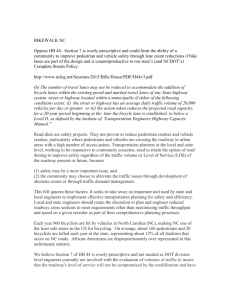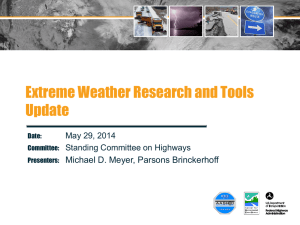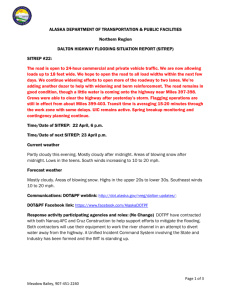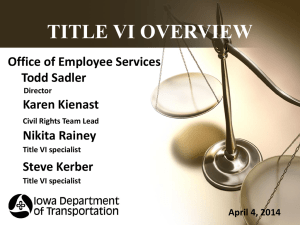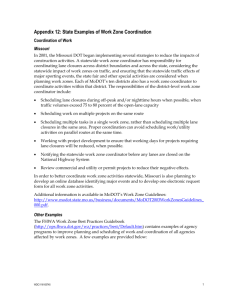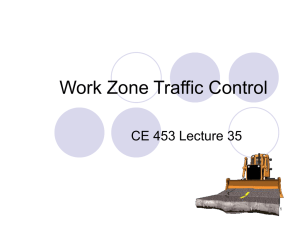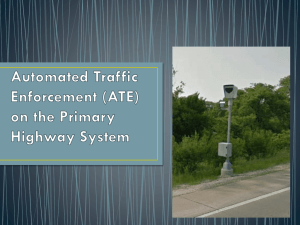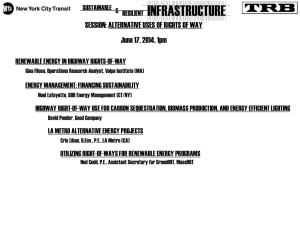22 Cross Sections
advertisement
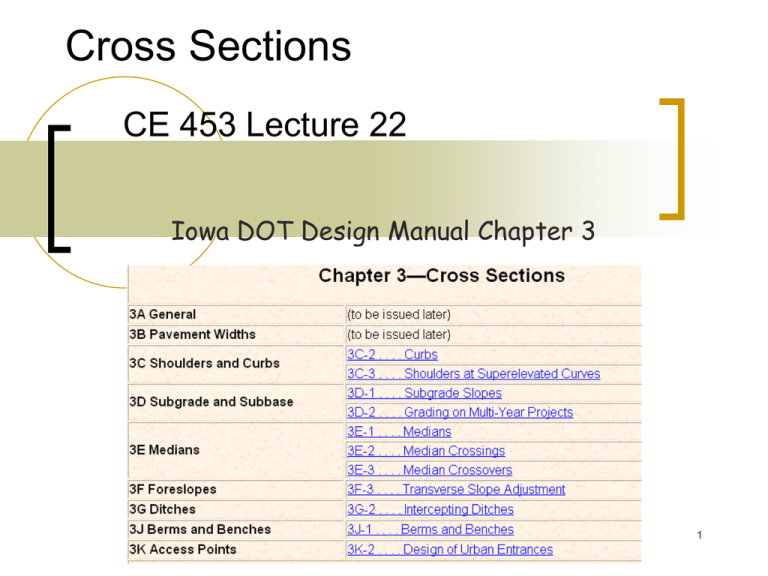
Cross Sections CE 453 Lecture 22 Iowa DOT Design Manual Chapter 3 1 See also Iowa DOT Standard Plans 2 Objectives 1. Identify cross section components and design criteria See: http://www.fhwa.dot.gov/environment/flex/ch06.htm (Chapter 6 from FHWA’s Flexibility in Highway Design) 3 Cross Section Elements 1. Roadway 2. Median 3. Roadside Roadway Components 1. Travel Lanes 2. Shoulders 4 Source:http://www.fhwa.dot.gov/environment/flex/ch06.htm Cross Section Elements 1. Roadway 2. Median 3. Border Roadway Components 1. Travel Lanes 2. Auxiliary Lanes 5 Source:http://www.fhwa.dot.gov/environment/flex/ch06.htm Considerations for Design of Cross-Section Volume and composition (percent trucks, buses, and recreational vehicles) of the vehicular traffic likelihood of bicyclists and pedestrians using the route Flexibility in Highway Design Chapter 6 6 Considerations for Design of Cross-Section Climatic conditions (storage space for plowed snow, amount of rain) Presence of natural or human-made obstructions adjacent to the roadway (rock cliffs,etc) Type and intensity of development along the facility Safety of the users (speed of traffic) 7 Travel Lanes Function: guidance to drivers and vehicle support Pavement types: high (modern standards), intermediate (surface treatments), and low (unpaved) 8 Travel Lanes Selection Criteria: Traffic volume and composition Soil characteristics Past performance in area Availability of materials Energy conservation Initial cost Maintenance cost Overall life-cycle cost 9 Cross Slope Slope perpendicular to flow of traffic on tangent section Rural – normal crown – uniform slope from center to edge of pavement (cross slope break typically at centerline) Urban – parabolic shape (gutter capacity) 10 Cross Slope • • • Rate of Cross Slope = f(drainage, steering, and rollover or cross slope break) Drivers cross the crown line during passing maneuvers • Difficult to negotiate steep slopes AASHTO Recommends • High 1.5 to 2% (0.015 ft/ft m/m) • Intermediate 1.5 to 3% • Low 2 to 6% 11 12 Urban Cross-Sections 13 Urban Cross-Sections 14 HMA Cross-Sections 15 Drainage Considerations 16 Drainage Considerations 17 Roadway Component – Travel Lane Lane Width Considerations • • • • • • What is the impact of weather on cross slope design? Safety: Allow steering adjustment and lateral clearance Pavement edge crumbling (deterioration) less with wide lane Cost/Benefit (depends on traffic) Bicycle Use 18 Lane Width Limited by physical dimension of vehicles 12 ft desirable 11 ft acceptable in urban areas with restrictions 10 ft okay for low speed/urban roadways 9 ft – okay low volume rural and residential roadways 14 ft – shared outside lane with bike TWLTL 10 – 16 ft (3.0 – 4.8m) Auxiliary 10 ft. (3.0 m) or more 19 Shoulders • • • • • • • Functions: Lateral Support Avoidance Space Emergency Stop Ped/Bike Use Turning/Passing at Intersections Mail Delivery, Buses, etc. Flexibility in Highway Design Chapter 6 20 Shoulders Should be flush with roadway surface Sloped to drain away from traveled way Should be stable enough to support vehicles in all kinds of weather w/out rutting Should be visibly different from traveled way 21 Shoulder geometry Paved/Unpaved (earth, turf, gravel) Graded and usable width depends on foreslope and rounding Consider function, safety, and capacity impacts Slope 2 to 6% (paved) 4 to 6% (gravel) 8% (turf) Min. 2% + lane slope Max crossover 8%] Width 0.6 – 3.6 m (2 – 12 ft) 22 Source: A Policy on Geometric Design of Highways and Streets (The Green Book). Washington, DC. American Association of State23 Highway and Transportation Officials, 2001 4th Ed. Curbs Control access Control drainage Type used varies with location and design speed 24 Curbs 25 Curbs 26 Iowa’s Roadway-Related Fatal Crashes 52% of Iowa’s fatalities are related to Lane Departure 39% of Iowa’s fatal crashes are single-vehicle Run-Off-the-Road (ROR) crashes 27 Safety Investment Strategy Candidate Safety Projects Paved shoulders Milled-in shoulder rumble strips 2-lane shoulder widening High severity crash intersections High severity crash 2-lane roads High crash curves Expressway intersections Centerline rumble strips Cross-median head-on crashes 28 4 Foot Paved Shoulder US 63 29 Milled Shoulder Rumble Strips 30 Median Function ► ► ► ► ► ► ► Separate opposing traffic Drainage Aesthetics Space for future lanes Recovery Access control Minimize headlight glare Flexibility in Highway Design Chapter 6 31 Median Types/Geometry Depressed (rural arterials, 6:1 preferred, 4:1 min) Raised (urban arterials) Flush (urban/sub. some rural) Double yellow to limit access TWLTL Width is determined by Function Safety Need for independent design Flexibility in Highway Design Chapter 6 32 Iowa DOT Urban Design Aids See http://www.dot.state.ia.us/local_systems New Construction 33 Iowa DOT Urban 3R* Guidelines See http://www.dot.state.ia.us/local_systems 34 *Resurfacing, Restoration, Rehabilitation Rural Design - New Construction 35
